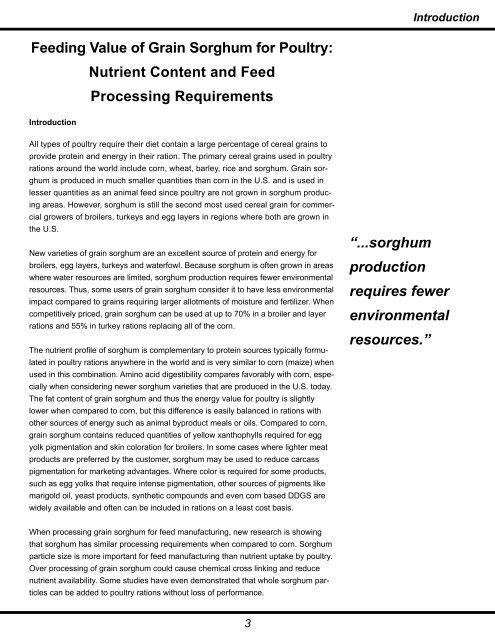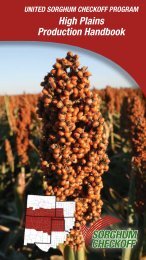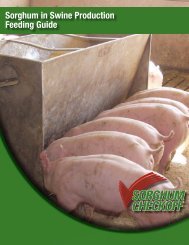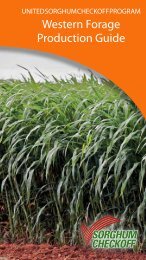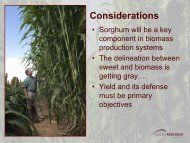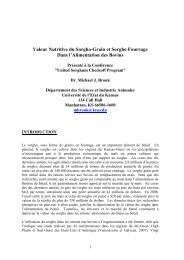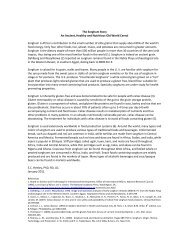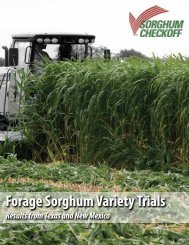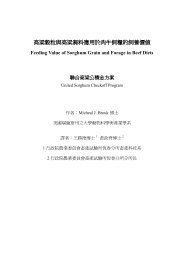Sorghum in Poultry Production Feeding Guide - Sorghum Checkoff
Sorghum in Poultry Production Feeding Guide - Sorghum Checkoff
Sorghum in Poultry Production Feeding Guide - Sorghum Checkoff
You also want an ePaper? Increase the reach of your titles
YUMPU automatically turns print PDFs into web optimized ePapers that Google loves.
Introduction<br />
Feed<strong>in</strong>g Value of Gra<strong>in</strong> <strong>Sorghum</strong> for <strong>Poultry</strong>:<br />
Nutrient Content and Feed<br />
Process<strong>in</strong>g Requirements<br />
Introduction<br />
All types of poultry require their diet conta<strong>in</strong> a large percentage of cereal gra<strong>in</strong>s to<br />
provide prote<strong>in</strong> and energy <strong>in</strong> their ration. The primary cereal gra<strong>in</strong>s used <strong>in</strong> poultry<br />
rations around the world <strong>in</strong>clude corn, wheat, barley, rice and sorghum. Gra<strong>in</strong> sorghum<br />
is produced <strong>in</strong> much smaller quantities than corn <strong>in</strong> the U.S. and is used <strong>in</strong><br />
lesser quantities as an animal feed s<strong>in</strong>ce poultry are not grown <strong>in</strong> sorghum produc<strong>in</strong>g<br />
areas. However, sorghum is still the second most used cereal gra<strong>in</strong> for commercial<br />
growers of broilers, turkeys and egg layers <strong>in</strong> regions where both are grown <strong>in</strong><br />
the U.S.<br />
New varieties of gra<strong>in</strong> sorghum are an excellent source of prote<strong>in</strong> and energy for<br />
broilers, egg layers, turkeys and waterfowl. Because sorghum is often grown <strong>in</strong> areas<br />
where water resources are limited, sorghum production requires fewer environmental<br />
resources. Thus, some users of gra<strong>in</strong> sorghum consider it to have less environmental<br />
impact compared to gra<strong>in</strong>s requir<strong>in</strong>g larger allotments of moisture and fertilizer. When<br />
competitively priced, gra<strong>in</strong> sorghum can be used at up to 70% <strong>in</strong> a broiler and layer<br />
rations and 55% <strong>in</strong> turkey rations replac<strong>in</strong>g all of the corn.<br />
The nutrient profile of sorghum is complementary to prote<strong>in</strong> sources typically formulated<br />
<strong>in</strong> poultry rations anywhere <strong>in</strong> the world and is very similar to corn (maize) when<br />
used <strong>in</strong> this comb<strong>in</strong>ation. Am<strong>in</strong>o acid digestibility compares favorably with corn, especially<br />
when consider<strong>in</strong>g newer sorghum varieties that are produced <strong>in</strong> the U.S. today.<br />
The fat content of gra<strong>in</strong> sorghum and thus the energy value for poultry is slightly<br />
lower when compared to corn, but this difference is easily balanced <strong>in</strong> rations with<br />
other sources of energy such as animal byproduct meals or oils. Compared to corn,<br />
gra<strong>in</strong> sorghum conta<strong>in</strong>s reduced quantities of yellow xanthophylls required for egg<br />
yolk pigmentation and sk<strong>in</strong> coloration for broilers. In some cases where lighter meat<br />
products are preferred by the customer, sorghum may be used to reduce carcass<br />
pigmentation for market<strong>in</strong>g advantages. Where color is required for some products,<br />
such as egg yolks that require <strong>in</strong>tense pigmentation, other sources of pigments like<br />
marigold oil, yeast products, synthetic compounds and even corn based DDGS are<br />
widely available and often can be <strong>in</strong>cluded <strong>in</strong> rations on a least cost basis.<br />
“...sorghum<br />
production<br />
requires fewer<br />
environmental<br />
resources.”<br />
When process<strong>in</strong>g gra<strong>in</strong> sorghum for feed manufactur<strong>in</strong>g, new research is show<strong>in</strong>g<br />
that sorghum has similar process<strong>in</strong>g requirements when compared to corn. <strong>Sorghum</strong><br />
particle size is more important for feed manufactur<strong>in</strong>g than nutrient uptake by poultry.<br />
Over process<strong>in</strong>g of gra<strong>in</strong> sorghum could cause chemical cross l<strong>in</strong>k<strong>in</strong>g and reduce<br />
nutrient availability. Some studies have even demonstrated that whole sorghum particles<br />
can be added to poultry rations without loss of performance.<br />
3


